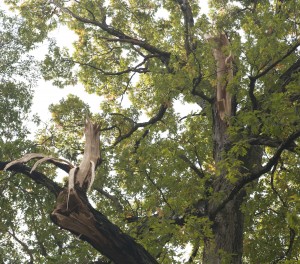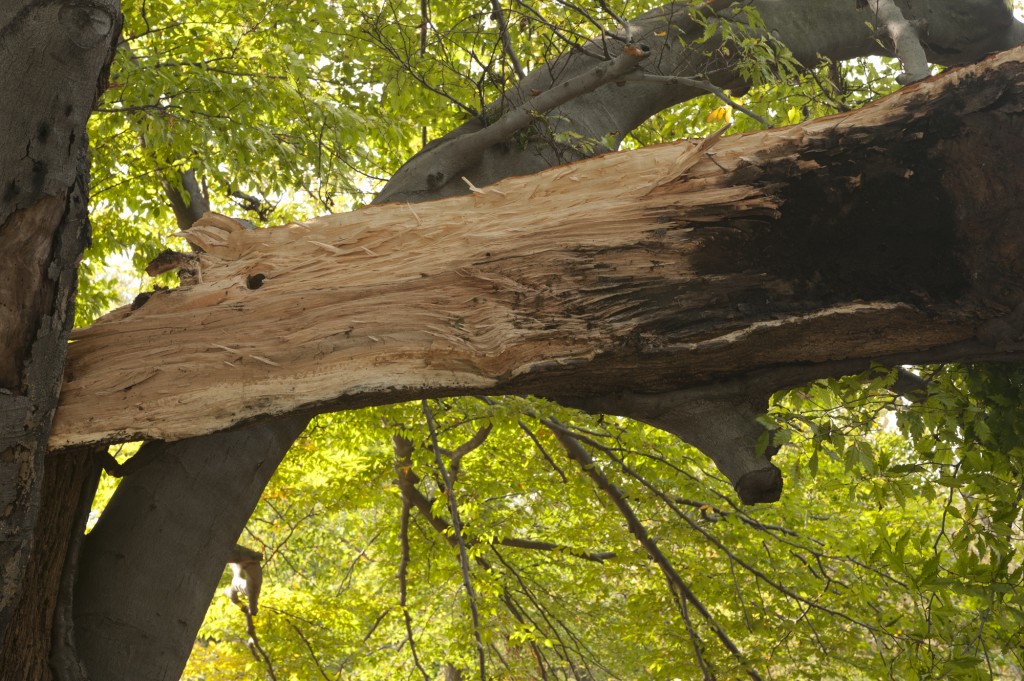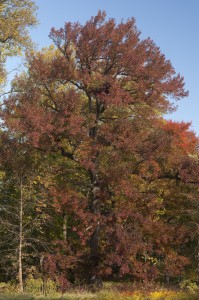Snow-tober: Assessing the Structural Damage of Trees
Posted in Around the Garden on January 10 2012, by Sonia Uyterhoeven
Sonia Uyterhoeven is the NYBG’s Gardener for Public Education.
 Trees possess a physiognomy and physiology just like we do. If you are an arborist, a dendrologist, or just a lover of trees, you can walk into the woods and read the life stories of your local trees simply by tilting your head upwards and carefully observing your surroundings.
Trees possess a physiognomy and physiology just like we do. If you are an arborist, a dendrologist, or just a lover of trees, you can walk into the woods and read the life stories of your local trees simply by tilting your head upwards and carefully observing your surroundings.
In lay terms this means that you can tell a lot about a tree just by looking at it and understanding the basics of how it functions. The snow storm we encountered at the end of October was an opportunity to reflect on the intimate relation that growth, structure, and environmental impact have on the lives of trees. I subtitled last week’s blog “No Tree Left Behind” because virtually every tree was at the mercy of last October’s unexpected snow, when the majority of deciduous trees still had full canopies.
An assessment of the storm damage here at The New York Botanical Garden reveals important lessons that help us understand which trees are generally hardest hit during a storm and why. Today I am going to discuss three variables that affect resistance to storm damage.
One has to do with the actual structure of the wood in different species. Some trees such as sweet gums (Liquidambar styraciflua), hickories (Carya sp.), willows (Salix sp.), tulip trees (Liriodendron tulipifera), and Chinese elms (Ulmus parvifolia) are weak-wooded species. They tend to be more susceptible to storm damage.
The October snow storm demonstrated the veracity of this claim, with the majority of the damage in the Garden incurred on the above species. As a homeowner, if you are choosing a tree for your property which will sustain minimal storm damage, the general consensus amongst the woody plant crowd is that slow-growing trees tend to be more structurally sound than fast-growing trees. The fast growers are generally the species with weaker wood.

Another reason has to do with pockets of decay and past pruning injuries. Several decades ago, when it came to making major pruning cuts on trees, the common belief was that you were supposed to make a flush cut. This meant that you followed the branch back to where it met the central stem and made a clean cut at the base of the connection for doing the right cuts you need the right equipment from Chain Cutting to pruning. Research has now shown that it is best to make the pruning cut in an area that lies just slightly outside of what is called the branch bark ridge and the branch collar. In simplified terms, this is the location where the wood from the central stem joins with the wood from the branch.
By making the cut outside this area you are essentially avoiding damage to the living tissues of the central stem, for this aesthetictree.ca tree service professionals provided some in-field information. Only the branch tissues will be damaged from the cut, and if it is close to the area where the two tissues connect then it will callous over and heal quickly. Old flush cuts that remain on trees or poorly-made pruning cuts will contain pockets of decay or areas of weakened wood that will be targets for any severe weather that taxes the strength of the tree. It is nature’s way of cleaning house.
Narrow branch angles are the third variable in winter storm damage. The problem with narrow branch angles is that as the branch and the central stem become larger, they begin running out of space to grow. They become crammed into a small space causing their bark to fold over onto itself. The technical term for this is included bark.
 There is no space for a strong, woody connection between the branch and the central stem to grow and the structurally weaker bark fills the space. In this instance, the branch becomes heavier as it grows, but the strength of the woody connection between the branch and the main stem doesn’t correspond to its size and leads to a weak connection. Arborists who are making risk assessments on trees look for what those in the trade term “elephant ears.” These are signs that there is included bark. From the ground it looks like the branch has grown a funny bulge or, as the name implies, ears.
There is no space for a strong, woody connection between the branch and the central stem to grow and the structurally weaker bark fills the space. In this instance, the branch becomes heavier as it grows, but the strength of the woody connection between the branch and the main stem doesn’t correspond to its size and leads to a weak connection. Arborists who are making risk assessments on trees look for what those in the trade term “elephant ears.” These are signs that there is included bark. From the ground it looks like the branch has grown a funny bulge or, as the name implies, ears.
If you survey your property and look for weak-wooded trees, old pruning cuts that never healed properly, and narrow branch angles, you will come away with an accurate idea of where potential storm damage may occur. That is, of course, if the past year hasn’t already taken care of it.


Thank you, ‘find tree pruning advice’ has been on my to do list for a while… don’t you just love it when serendipity/some body else enables you to give a satisfying tick to that list!